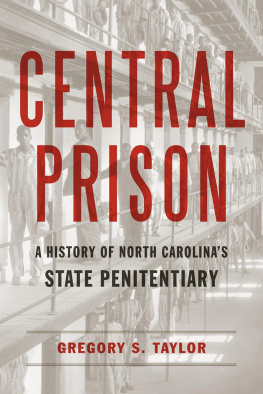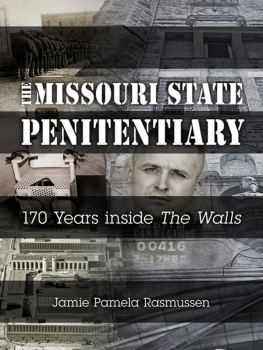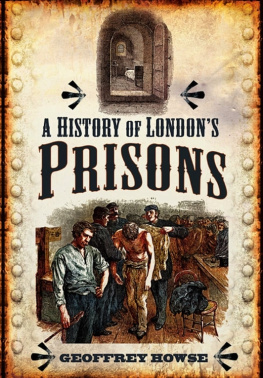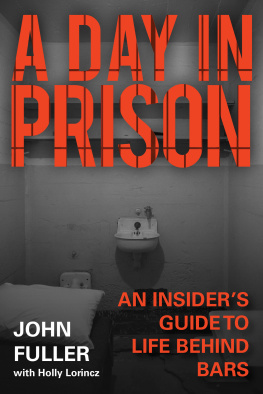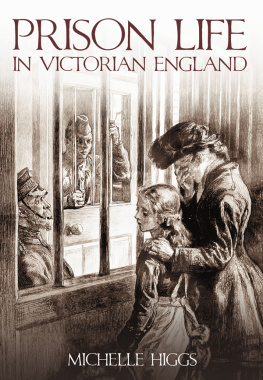CENTRAL
PRISON
CENTRAL
PRISON
A HISTORY OF NORTH CAROLINAS
STATE PENITENTIARY
GREGORY S. TAYLOR

LOUISIANA STATE UNIVERSITY PRESS
Baton Rouge
Published by Louisiana State University Press
www.lsupress.org
Copyright 2021 by Louisiana State University Press
All rights reserved. Except in the case of brief quotations used in articles or reviews, no part of this publication may be reproduced or transmitted in any format or by any means without written permission of Louisiana State University Press.
Manufactured in the United States of America
First printing
DESIGNER : Mandy McDonald Scallan
TYPEFACE : Whitman
PRINTER AND BINDER: Sheridan Books, Inc.
Jacket image: Photograph courtesy the North Carolina Museum of History.
Library of Congress Cataloging-in-Publication Data
Names: Taylor, Gregory S., author.
Title: Central Prison : a history of North Carolinas State Penitentiary / Gregory S. Taylor.
Description: Baton Rouge : Louisiana State University Press, [2021] | Includes bibliographical references and index.
Identifiers: LCCN 2020028532 (print) | LCCN 2020028533 (ebook) | ISBN 978-0-8071-7433-3 (cloth) | ISBN 978-0-8071-7487-6 (pdf) | ISBN 978-0-8071-7488-3 (epub)
Subjects: LCSH: Central Prison (Raleigh, N.C.)History. | PrisonsNorth CarolinaHistory.
Classification: LCC HV8353 .T38 2020 (print) | LCC HV8353 (ebook) | DDC 365/.975655dc23
LC record available at https://lccn.loc.gov/2020028532
LC ebook record available at https://lccn.loc.gov/2020028533
For Mom, Dad, Darren, Becky, and Thomas
CONTENTS
ACKNOWLEDGMENTS
I owe William Hinkle my utmost thanks for introducing me to this topic, for working with me on a previous publication, and for providing some of the foundational sourcing and material. Without his early assistance, this work would not have been possible. Thanks, Bill.
As they have throughout my entire career, my family supported me during this project. They put up with my obsessions and wanderings, humored me as I worked through various drafts, and offered support when needed. I cannot imagine having achieved any level of accomplishment had it not been for them.
The faculty, staff, and administration at Chowan University have been similarly supportive. My colleagues Edward Snyder and David Ballew took on any number of administrative and extracurricular duties that freed me up to research and write. Provost Danny Moore has done even more to ensure I had the time and resources to take on my many projects, and I cannot overstate my thanks to him for all his assistance over the last fifteen years. President Kirk Peterson and Chancellor M. Christopher White have presided over the university during my tenure, and I am thankful for their vision and leadership. And to all those many colleagues who have passed through the Chowan community, whose names are too many to mention, I offer my thanks for your friendship and support.
The North Carolina Collection of the Wilson Library Special Collections unit at the University of North Carolina at Chapel Hill is a wonderful resource. I spent more than a few weeks in the friendly confines, and I appreciate the assistance provided by the archival staff, led by Curator Robert Anthony. Their knowledge, friendliness, interest, and support made the long days of research successful and fulfilling. I always enjoy my trips to Chapel Hill, and look forward to continuing my relationship with the archival staff.
Rand Dotson and the entire staff at the Louisiana State University Press have been a pleasure to work with. I cannot thank them enough for their hard work, patience, guidance, support, and advice along the way. The same is true for Derik Shelor, whose meticulous editing dramatically improved this work. I thank you all.
CENTRAL
PRISON
INTRODUCTION
On July 20, 1910, British home secretary Winston Churchill stood before the House of Commons and said, The mood and temper of the public in regard to the treatment of crime and criminals is one of the most unfailing tests of the civilization of any country. Two generations earlier, having experienced Russian civilization during four years in Siberian exile, author Fyodor Dostoevsky allegedly offered a similar sentiment with this oft quoted though unsourced aphorism: the degree of civilization in a society can be judged by entering its prisons. The present study of the North Carolina State Penitentiary, also known as Central Prison, seeks to demonstrate how apt those thoughts are.
This is not the first study to investigate the social/penological relationship. Writing in the 1920s, historian Harry Barnes saw a correlation between the two when he discussed the reform movements of the nineteenth century. He discovered that the rise of prohibition, abolition, juvenile justice, and mental health advocacy coincided with an effort toward prison reform. Barnes thus contended that the desire to improve society included the desire to help even those whose actions placed them outside traditional social norms. A decade later, penologist Blake McKelvey found the origins of penal reform even earlier when he asserted that Quaker religious idealism led Pennsylvania to adopt rehabilitative efforts designed to better both the criminal and society. McKelvey thus affirmed that a societal force, in this case religion, directly affected prison life.
While others made similar claims, the appreciation of a causal relationship between society and prison remained marginal for much of the twentieth century. According to penal scholar Peter Smith, the critical philosophical and sociological literature on prisons and their relation to society has appeared especially since the 1970s. He links this appearance to the 1975 publication of Michele Foucaults Discipline and Punish, which explored the diffusion of disciplinary mechanisms throughout the social body. Smith acknowledges that Foucault did not view prison as a reflection of society and modernity, but admits to studying that reflection nonetheless. Unintentionally, Foucaults work sparked a renewed interested in the social/penological relationship and revived the inquiries made by Barnes and McKelvey.
That revival has quickened in recent decades thanks to the work of any number of scholars. Penologist Donald Clemmer asserts that the prison is a microcosm of society, finds the existence of numerous parallels between the prison and the free world, and concludes that the culture of the prison reflect[s] the American culture. Legal scholar Lawrence Friedman concurs, arguing that the methods of punishment are always related to what is happening in the larger world, with the result that prisons are a microcosm of the outside world. Countless other scholars agree, and appreciate that developments in the free world are manifest within the prison walls because prisons are a part of the social order populated by members of that order.
That embodiment, however, is not analogous. A decade after declaring prison a microcosm of the outside world, Friedman revised his assessment and declared prison a warped version of society: a funhouse mirror, as it were. The relationship between prison and society, he contends, is direct but exaggerated. Others joined Friedman in this interpretation. Criminologists Larry Siegel and Clem Bartollas assert that poverty, racial and gender discrimination, violent crime, and mental illness are found in exaggerated forms within the prison, while the New York State Special Commission on Attica determined that prison magnifies and intensifies social forces. Both assessments portray prison as engendering a distorted version of reality. Such a conclusion seems apposite, as contemporary studies find prison populations younger, blacker, poorer, and less mentally stable than society at large.

